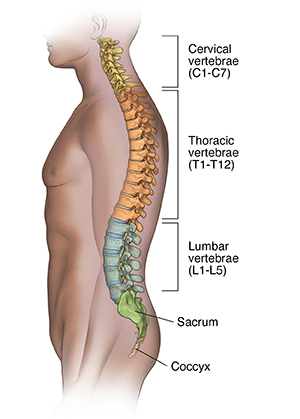Lumbar Strain
What is a lumbar strain?
A lumbar strain is an injury to the low back. This leads to damaged tendons and muscles that can spasm and feel sore. The lumbar vertebrae make up the section of the spine in your low back.
What causes lumbar strain?
Injury can damage the tendons and muscles in the low back. Pushing and pulling sports, such as weightlifting or football, can lead to a lumbar strain. So can sports that need sudden twisting of the low back. These include tennis, basketball, baseball, and golf.
Certain risk factors can increase the risk for this injury. The risk factors are:
Severe low back curvature
Forward-tilted pelvis
Weak back or belly (abdominal) muscles
Tight hamstrings
What are the symptoms of lumbar strain?
. Each person's symptoms may be different. Symptoms may include:
Sudden low back pain
Spasms in the low back that result in more severe pain
Low back feels sore to the touch
Some of these symptoms may be caused by other health problems. Always talk with your healthcare provider for a diagnosis.
How is lumbar strain diagnosed?
The provider will take a complete health history and do a physical exam. Special tests are not often needed for diagnosis. But you may have some tests done such as:
X-ray. A diagnostic test that makes images of internal tissues, bones, and organs onto film.
CT scan. This is an imaging test that uses X-rays and a computer to make detailed images of the body. It shows details of the bones, muscles, fat, and organs.
MRI. This test uses a combination of large magnets, radiofrequencies, and a computer. It makes detailed images of organs and structures in the body.
Radionuclide bone scan. A nuclear imaging method that uses a very small amount of radioactive material. This is injected into your blood to be found by a scanner. This test shows blood flow to the bone and cell activity in the bone.
Electromyogram. A test to check nerve and muscle function.
How is lumbar strain treated?
Treatment will depend on your symptoms, age, and general health. It will also depend on how bad the condition is.
Treatment may include:
Rest
Ice packs or heat and compression applied to the back
Exercises (to strengthen the abdominal muscles)
Stretching and strengthening exercises (for the low back as it heals)
Learning how to use and wear correct protective equipment
Medicines may also be used to ease pain and inflammation. These include anti-inflammatories, muscle relaxants, and spinal injections.
When should I call my healthcare provider?
Call your healthcare provider if you have any of these:
Can't stand or walk
Temperature over 101.0°F (38.3°C) or as advised by your provider
Chills
Frequent, painful, or bloody urination
Severe belly pain
Sharp, stabbing pain
Constant pain
Pain or numbness in your leg
Pain in a new area of your back
The pain isn't decreasing after more than a week
Call your healthcare provider right away if you have any of these:
Pain spreading down the leg.
Pain as well as fever or chills, leg weakness, or loss of control of the bladder or bowels.
Living with lumbar strain
Cold reduces swelling. Both cold and heat can reduce pain. Protect your skin by placing a towel between your body and the ice or heat source.
For the first few days, apply an ice pack for
15 to 20 minutes.After the first few days, try heat for
15 minutes at a time to ease pain. Never sleep on a heating pad.Over-the-counter medicines can help control pain and swelling. Try aspirin or ibuprofen.
Exercise
Exercise can help your back heal. It also helps your back get stronger and more flexible, helping prevent reinjury. Ask your healthcare provider about specific exercises for your back.
Use good posture to prevent reinjury
When moving, bend at the hips and knees. Don't bend at the waist or twist around.
When lifting, keep the object close to your body. Don't try to lift more than you can handle.
When sitting, keep your lower back supported. Use a rolled-up towel as needed.
Key points about lumbar strain
Lumbar refers to your lower back.
Strain can cause damage to the tendons and muscles causing pain and soreness.
Nonsurgical methods can cure most low back pain.
Call your healthcare provider if symptoms don't get better over the next few days or if symptoms get worse.
Next steps
Tips to help you get the most from a visit to your healthcare provider:
Know the reason for your visit and what you want to happen.
Before your visit, write down questions you want answered.
Bring someone with you to help you ask questions and remember what your provider tells you.
At the visit, write down the name of a new diagnosis, and any new medicines, treatments, or tests. Also write down any new instructions your provider gives you.
Know why a new medicine or treatment is prescribed, and how it will help you. Also know what the side effects are.
Ask if your condition can be treated in other ways.
Know why a test or procedure is recommended and what the results could mean.
Know what to expect if you do not take the medicine or have the test or procedure.
If you have a follow-up appointment, write down the date, time, and purpose for that visit.
Know how you can contact your provider if you have questions, especially after office hours or on weekends.
